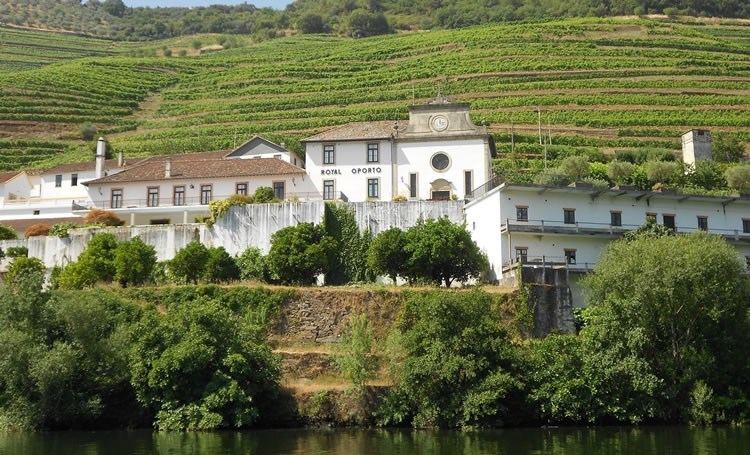Over centuries small Quintas (estates) have been bought and sold so that corporations - some still in family hands - now own many single Quintas and often have contracts with hundreds of grape farmers. Five companies produce 80% of the Douro’s total. Symington, for example, controls 22% of the whole area and deals with 3000 grape growers (there are 25000 in the region!).
Many owners, or ‘houses’ (traditionally shippers), are linked, so for example, Sogrape owns Sandeman (which has Quinta de Seixo) Offley and Ferreira. The Fladgate Partnership owns Croft, Taylor’s and Fonseca. Symington owns Dows and Grahams amongst its 26 estates, and has Quinta do Bomfim in its portfolio as a single entity. The tradition here is one of accumulated ownership.
Quinta do Bomfim sees 200 visitors a day in summer, sells several portfolio producers at its Douro tasting rooms eg Grahams, Cockburns, Warre’s, Dows, Altano, Quinta de Ataíde, and its own single Quinta ports and offers the splendid Quinta do Vesuvio ports to visitors - also owned by Symingtons.
For some, tradition remains, irrigation is illegal, the list of varieties is unchanged, Q. do Bomfim has a sandy dirt cellar floor so it can be soaked to cool the old oak vats (even the 63000L vat), top Quintas still use open granite lagares and teams of people to tread the grapes, then transport the young fortified wine to Vila Nova de Gaia for blending, aging and bottling before shipping.
Quinta do Noval (AXA Millésimes) uses Vila Nova but keeps control of its top wines at the estate in the Douro. Noval reflects tradition, 90% of the grapes it uses are its own (most buy in 90% of their grapes), only A grade vineyards are used, on blue schist soil (great heat moderation), 10% are field blends, occasional Patamares remain (unwalled terraces), teams of people treading grapes for 3 hours every evening for 2 months (each lagare only once, then to manual punch downs for 3 days then spirit added), 80% whole bunch with stems, old wood aging. Noval has 3 million litres of Tawnys from the 1930’s slumbering in dark cellars.
Tradition has evolved elsewhere. Many producers, and some top Quintas, train vines on a single cordon to reduce yields (around 1kg per vine), some are deliberately planting as field blends like the past and are using mechanical ‘feet’ to tread the grapes as many have lost their labour force (Q. do Bomfim heat the silicon feet to 37°C to mimic the temperature of the human foot). Steel and water cooled lagares have replaced granite and concrete.
Lack of workers is an accepted feature of the Douro, but lately it seems young people are returning to the vineyards and cellars as job opportunities elsewhere have dwindled. Some 6000 youngsters descend on the Douro at harvest time. Not enough yet for assistant Alvaro at 200 year old Quinta do Infantado, who says lack of workers is still evident.
Another break in tradition is the single varietal fermentation from single varietal planting (introduced by Taylor’s in the 1920’s) to match varying ripening times, and allow more blending options (normal is often mixed field blends and 2 or 3 varieties co-fermented).
Since permission was granted in the ‘80s, some Quintas are not using Vila Nova at all, many ferment, mature, blend and bottle in the Douro. Some top houses retain the Oporto lodges mostly for tourists, not all Gaia lodges hold casks of aging ports anymore. Q. do Bomfim still does, believing that losing 3% of wine evaporating in the Douro because of the dryness, compared to 1 ½ % in Vila Nova makes it good sense to use the old lodges opposite Oporto.
Whereas the remote Douro needed Vila Nova to market and distribute and sell its wines, it was three days away by the river (and five back) in the days of the Rabelo boats, now the buyers are coming to the Douro and direct sales and distribution from the Quinta is common.
The rise of Douro table wine, sold as Douro DOC to distinguish it from Port, has been rapid. Most Quintas make table wines using Port varieties and others such as Muscat, Sauvignon Blanc, Gewurztraminer and Semillon (disallowed in Port, allowed as Douro DOC) and are making dry White Ports and Rosé Ports (very popular and used as cocktails - a 20% alcohol rosé). Table wines sell more than Port.
Consumer taste has moved away from the classic Port style. For every 6 bottles of Vintage Port sold, Alvaro, (who has worked at Beaumont in Bot River with Sebastian Beaumont) thinks they might sell 1000 bottles of LBV. Infantado are also moving away from sweet Ports, fermenting drier to some 50g/l RS. Taylor’s have around 30g/L in their Dry Port.
Touriga Nacional is no longer so dominant in the Douro, either. We think of Port as T.Nacional based, with a list of others. The reality, says Alvaro at Quinta do Infantado, is that the Nacional is probably less than 5% of the Douro, Touriga Franca, or Francesca is some 30% and then comes the Tinta’s; Roriz, Cão and Barroca. Surprisingly, 25% of the Douro is now planted with white varieties.
The Douro is not really re-inventing itself, just moving with the times after 350 years of Port winemaking. New styles, cocktail Ports, Rosés, botrytis wines, dry whites, table reds and serious tourism, but behind it all, classic 20, 30 and 40+-year-old Tawnys and Vintage Ports that will age for a century.
